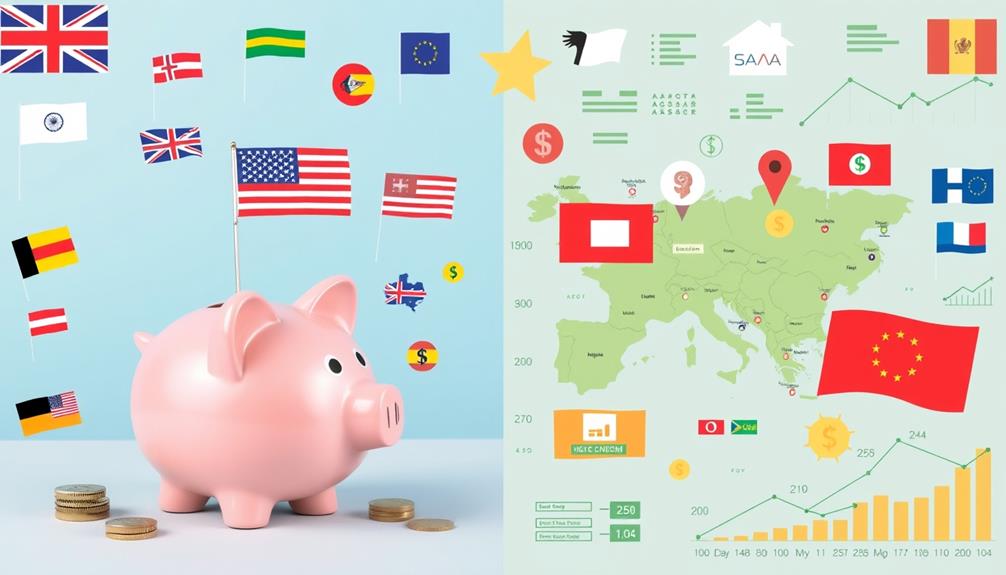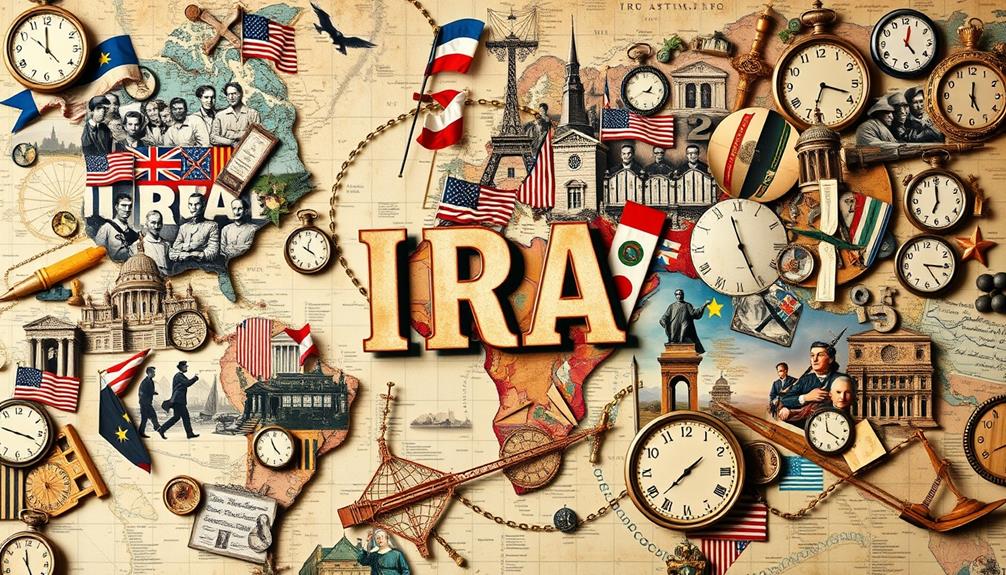When comparing U.S. IRAs with international retirement accounts, you will find significant differences. U.S. IRAs offer voluntary participation, which provides more personal choice but can result in lower participation rates and insufficient savings. In contrast, many countries such as Denmark and the Netherlands have mandatory contributions that lead to higher savings and improved retirement outcomes. When it comes to contributions, U.S. limits are modest in comparison to the generous options available in countries like Australia. Being aware of these distinctions can assist you in making informed decisions about your retirement plan, and there is plenty more to discover about global retirement systems and the choices available to you.
Key Takeaways
- The U.S. retirement system ranks 22nd globally, with significant challenges in participation rates and adequacy compared to countries like the Netherlands and Denmark.
- U.S. IRAs have low contribution limits of $6,500, while countries like Australia and Canada allow much higher tax-advantaged contributions.
- Unlike the U.S., many countries implement mandatory pension contributions, resulting in higher savings rates and better retirement security.
- U.S. IRAs offer tax-deferred growth but face penalties for early withdrawals, contrasting with more favorable tax treatments in other nations.
- Recommendations for the U.S. system include mandatory contributions, automatic enrollment, and simplified management to enhance retirement savings outcomes.
Overview of Global Retirement Systems
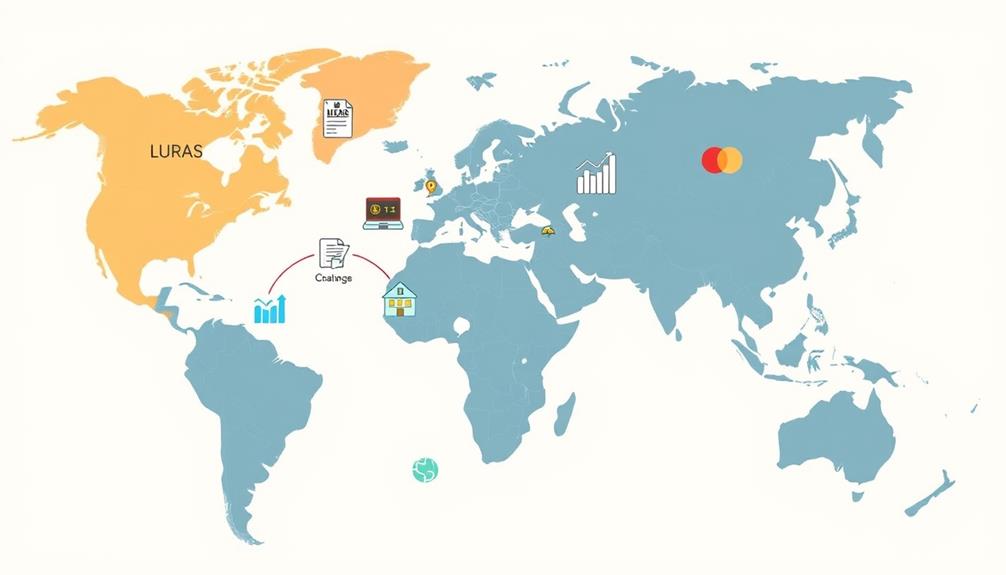
When you look at global retirement systems, you'll find there's a vast range in how countries approach retirement savings. For instance, countries like the Netherlands and Denmark boast strong mandatory pension contributions, yielding high net replacement rates for retirees. This contrasts sharply with the U.S., where many rely on voluntary participation in individual retirement accounts (IRAs) and 401(k)s, leading to significant gaps in pension coverage.
The U.S. also offers options such as Gold IRA Rollovers that can help diversify retirement portfolios and provide a hedge against inflation. In the Netherlands, you'll notice they rank first in the Mercer CFA Institute Global Pension Index, scoring an impressive 85/100. Meanwhile, the U.S. lags behind at 22nd place with a score of 63. This disparity highlights the differences in retirement security and governance between nations.
Additionally, Australia's Superannuation system mandates contributions from both employers and employees, covering a larger portion of the workforce compared to the U.S. system, where only about 50% participate in employer-sponsored plans.
Countries with higher coverage rates, like Denmark, guarantee that a significant percentage of their 65+ population enjoys more extensive retirement income sources, blending pensions and government payments, unlike U.S. IRAs that primarily depend on individual contributions and market performance.
U.S. Retirement System Ranking

The U.S. retirement system's ranking reveals significant challenges that impact many Americans' financial security in their later years. Ranked 22nd out of 47 countries with a score of 63 out of 100, the system earns a C+ grade in the 2023 Global Pension Index. This score highlights concerning declines in adequacy, sustainability, and integrity, emphasizing the need for improved retirement preparedness.
Furthermore, diversifying retirement portfolios, such as considering options like a Gold IRA, can serve as a protective strategy against inflation and market downturns diversification of retirement portfolio.
A major issue is that only 50% of workers participate in employer-based retirement plans, leading to a lack of universal coverage and increasing retirement insecurity. Unlike more robust pension plans in countries like the Netherlands and Denmark, which require contributions from both employers and employees, the U.S. system heavily relies on voluntary participation and Social Security as a mandatory pension contribution.
Additionally, low net replacement rates and high administrative costs further hinder effective retirement savings accumulation. While individual retirement accounts offer some benefits, the overall structure of the U.S. retirement system creates obstacles for many looking to secure their financial future.
Addressing these challenges is essential for improving retirement outcomes and ensuring that Americans can retire with confidence.
Performance Metrics of U.S. IRAs

When considering the performance metrics of U.S. IRAs, you'll notice significant differences in contribution limits and tax treatment compared to international accounts.
These factors play an essential role in how effectively you can save for retirement. For instance, many investors are exploring options like Gold IRAs as a way to diversify their portfolios.
Understanding these distinctions can help you make more informed decisions about your retirement strategy.
Contribution Limits Comparison
While U.S. contribution limits for IRAs may seem reasonable at first glance, they fall short compared to many international accounts. In 2023, you can contribute up to $6,500 if you're under 50, and $7,500 if you're 50 or older. This represents a modest increase aimed at keeping pace with inflation.
However, if you look at Australia's Superannuation system, the concessional contributions cap is AUD 27,500 (about USD 18,600), taxed at lower rates than regular income. This approach aligns with creating a personal budget that emphasizes long-term savings growth.
In the Netherlands, employees benefit from contributing up to 13.3% of their gross salary into retirement accounts, gaining additional tax advantages. These approaches reflect a more integrated view of retirement income, encouraging higher savings.
Moreover, the U.S. imposes income phase-out limits for Roth IRAs, starting at $138,000 for single filers, creating restrictions for higher earners.
In contrast, countries like Canada allow much more substantial contributions—CAD 30,780 (approximately USD 23,500) to Tax-Free Savings Accounts (TFSAs). These more generous contribution limits in other pension programs demonstrate a significant difference in how nations incentivize retirement savings.
Tax Treatment Differences
Tax treatment differences between U.S. Individual Retirement Accounts (IRAs) and international retirement plans can greatly affect your savings strategy. U.S. IRAs provide tax-deferred growth, meaning your investment earnings aren't taxed until you withdraw them, typically in retirement. This feature promotes long-term savings, aligning with the idea of personal responsibility in preparing for your financial future.
Additionally, investing in options like Gold IRAs can offer unique tax advantages and portfolio diversification, making them an appealing choice for those seeking to protect their retirement assets against economic instability Gold IRAs offer tax advantages.
When you contribute to a traditional IRA, those contributions might be tax-deductible, reducing your taxable income for that year. On the other hand, Roth IRAs allow for tax-free withdrawals in retirement, but you must meet specific conditions.
However, unlike some foreign accounts, U.S. IRAs impose annual contribution limits—$6,500 for those under 50 and $7,500 for those 50 and older as of 2023.
Early withdrawals before age 59½ may incur a 10% penalty, plus applicable income taxes, which encourages you to keep your funds invested longer. Comparatively, other countries may offer more favorable tax treatment on contributions and withdrawals, which could enhance your overall retirement savings.
Understanding these tax treatment differences is essential for making informed decisions about your retirement plans.
Comparison With International Accounts
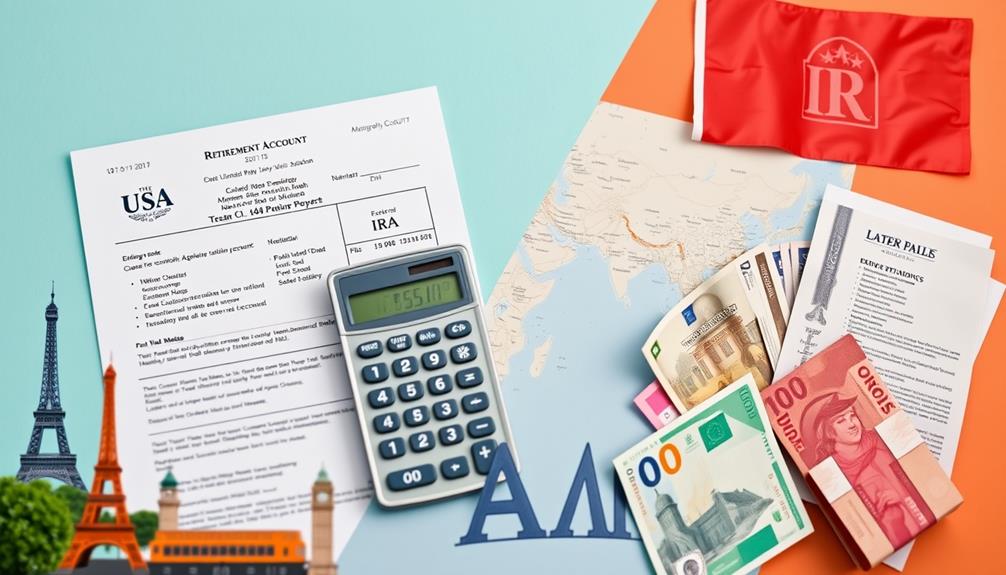
When you compare U.S. IRAs with international accounts, you'll notice key differences in features and tax treatment.
For instance, while U.S. IRAs impose contribution limits and penalties for early withdrawals, many countries offer more flexible options.
Additionally, it's essential to avoid Gold IRA scams by researching companies thoroughly and consulting with a financial advisor.
Understanding these differences can help you make informed decisions about your retirement savings strategy.
Key Account Features
In comparing key account features, U.S. Individual Retirement Accounts (IRAs) present distinct advantages and limitations compared to international accounts. For instance, U.S. IRAs allow for tax-deferred growth, letting your contributions grow without immediate taxation. However, international systems like Australia's Superannuation require mandatory contributions from both employers and employees, promoting higher retirement savings.
Here's a concise comparison of some key account features:
| Feature | U.S. IRAs | International Accounts |
|---|---|---|
| Contribution Requirements | Voluntary, with limits ($6,500/$7,500) | Mandatory contributions |
| Investment Flexibility | Wide range of options | Often collective strategies |
| Early Withdrawal Penalties | Yes, before age 59½ | More flexibility under certain conditions |
| Pension System Type | Individual accounts | Funded by social security systems |
While U.S. IRAs emphasize individual choice, other countries, like Denmark and the Netherlands, enforce mandatory pension plans, often resulting in better investment returns and financial security for retirees. Understanding these differences can help you make informed decisions about your retirement strategy.
Tax Treatment Differences
Understanding the tax treatment differences between U.S. IRAs and international retirement accounts is essential for effective planning. U.S. IRAs, including Traditional and Roth accounts, offer tax-deferred growth, with potential deductions based on your income.
In contrast, many foreign pensions and international accounts, like the UK's Individual Savings Accounts (ISAs), provide tax-free growth and withdrawals, which can be more advantageous. Additionally, investing in precious metals through a Gold IRA can enhance your retirement strategy by providing diversification and protection against inflation, as noted in Gold Investment Strategies.
When you withdraw from a Traditional IRA, it's taxed as ordinary income, while withdrawals from ISAs are tax-free. Additionally, the tax treatment of foreign pensions can vary widely. They may be subject to local tax rates or benefit from favorable tax treaty provisions with the U.S., influencing how your retirement funds are taxed upon withdrawal.
It's also important to note that U.S. tax rules require you to report foreign retirement accounts under FATCA if they exceed $10,000, which adds another layer of complexity.
On the flip side, some foreign retirement plans may still accept contributions from expats, even if you've established non-resident alien status, unlike U.S. IRAs. Understanding these differences can help you make informed decisions about your retirement savings strategy.
Contribution Limits Comparison
Tax treatment varies considerably between U.S. IRAs and international accounts, especially when looking at contribution limits. As of 2023, you can contribute up to $6,500 to your IRA if you're under 50, and $7,500 if you're 50 or older.
Understanding the financial implications of retirement accounts is essential for effective long-term planning, especially for those considering assisted living expenses. Compare that to Australia's Superannuation system, where the combined employer and employee contributions can reach AUD 30,000 for those under 49 and AUD 35,000 for those 49 and older.
In Canada, the Tax-Free Savings Account (TFSA) also allows for contributions of CAD 6,500, but the Registered Retirement Savings Plan (RRSP) lets you contribute up to 18% of your earned income, capped at CAD 30,780.
The Netherlands offers a more flexible approach, permitting contributions of up to 13.3% of your gross salary to your pension system, with added options for supplementary contributions.
Many countries, like Denmark, mandate pension contributions from both employers and employees, which can lead to notably higher retirement savings compared to the voluntary contributions typical in the U.S.
Understanding these differences can help you make informed decisions about your retirement planning.
Challenges in U.S. Retirement Savings

Retirement savings in the U.S. face significant hurdles that can leave many workers unprepared for their golden years. The U.S. retirement system ranks a disappointing 22nd out of 47 countries, receiving a C+ grade in the 2023 Melbourne Mercer Index. This indicates serious challenges in both savings adequacy and accessibility.
With only about 50% of employees participating in employer-based retirement plans, many struggle to accumulate sufficient savings. Effective Email Marketing Strategies can help organizations better communicate savings opportunities to their employees. The complexity and voluntary nature of the U.S. system can create decision paralysis, especially among younger workers who miss out on crucial saving opportunities.
High administrative costs tied to complicated retirement plans only add to the difficulties, making it harder for you to save effectively. Additionally, there's a significant disparity in retirement savings; top earners often reap the most benefits from employer contributions, leaving low- and middle-income individuals in a tough spot, struggling to maintain their pre-retirement living standards.
These various challenges highlight the pressing need for reforms to guarantee that all workers can secure a more stable financial future in retirement.
Key Features of Leading Global Systems

When it comes to effective retirement systems, several countries stand out for their innovative approaches and strong frameworks. The Netherlands, topping the global pension index, employs a hybrid model that combines public benefits with private pensions. This guarantees universal participation and high contribution rates, providing a solid foundation for retirement security.
Additionally, countries are increasingly focusing on sustainability and responsible investing, which can improve the long-term viability of retirement funds.
Australia's Superannuation system further illustrates success by mandating both employer and employee contributions. This results in higher net replacement rates for low- and middle-income workers compared to the U.S., offering considerable advantages.
Denmark, with its pension floor covering 72% of the population aged 65 and over, greatly outperforms the U.S. system, which only provides a pension floor equivalent to 15.6% of average worker earnings at retirement.
Countries like Iceland excel in sustainability and governance, showcasing strong fiduciary oversight and effective regulatory frameworks.
The OECD report emphasizes that nations with robust regulation and governance, such as the Netherlands and Denmark, demonstrate a commitment to long-term retirement benefits. This contrasts sharply with the U.S. system, which relies heavily on voluntary participation and complex structures, leading to potential gaps in retirement readiness.
Tax Implications for International Accounts

Maneuvering the tax implications of international retirement accounts can be complex, especially for U.S. citizens. The tax treatment of foreign pensions varies by country, influenced by specific tax treaties. These treaties can help mitigate double taxation, but understanding the nuances is essential for effective tax planning.
Here are some key considerations:
- Contributions to non-qualified foreign retirement plans are fully taxed as gross income under U.S. law.
- Withdrawals from foreign pensions may be subject to U.S. federal income tax or local taxation, depending on the applicable tax treaty.
- You must report foreign financial assets exceeding $50,000 on your tax returns, with higher thresholds for those living outside the U.S.
- The Foreign Account Tax Compliance Act (FATCA) requires reporting of foreign accounts over $10,000 to the U.S. Treasury.
- Managing tax treaties effectively can lead to valuable tax credits or exemptions, reducing the risk of double taxation.
Being proactive in understanding these tax implications can greatly impact your retirement strategy, ensuring you maximize benefits while complying with U.S. tax obligations.
Recommendations for U.S. System Improvements
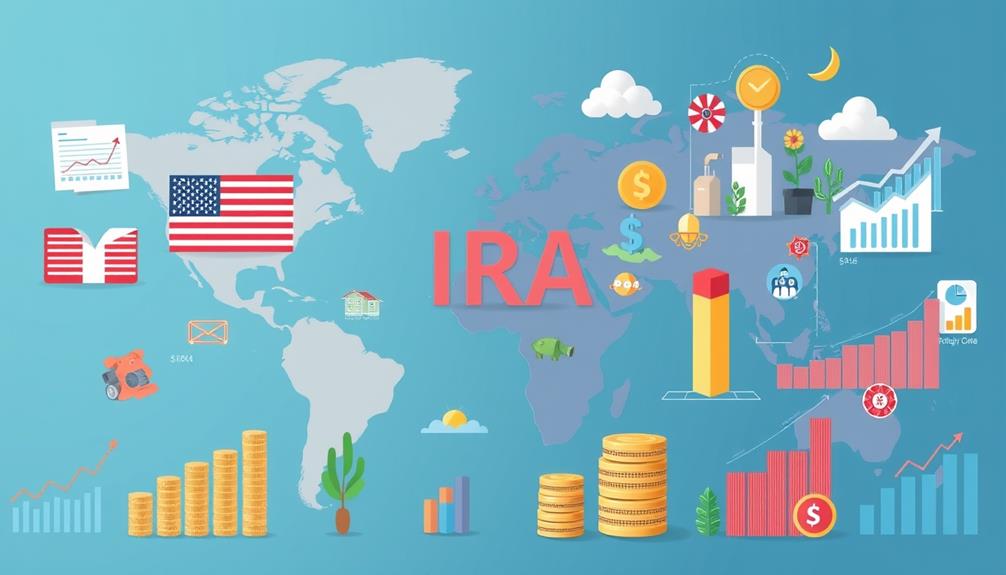
To enhance the U.S. retirement system, you might consider mandating savings contributions from both employers and employees, similar to Australia's model.
This could lead to more reliable income for low- and middle-income workers.
Additionally, simplifying retirement options can make it easier for everyone to participate and secure their financial future.
Mandated Savings Contributions
Mandating retirement savings contributions could transform the U.S. retirement landscape, much like Australia's Superannuation system, where both employees and employers are required to contribute.
By implementing a structure that guarantees consistent contributions, the U.S. can better address the shortcomings of its current reliance on Social Security and enhance overall retirement security.
Here are some key recommendations for improving the U.S. system through mandated savings contributions:
- Introduce Guaranteed Retirement Accounts (GRAs) that require a 3% contribution from both employers and employees.
- Establish collective bargaining agreements similar to those in Denmark and the Netherlands to guarantee universal pension plan coverage.
- Promote automatic enrollment in retirement accounts to increase participation rates among workers.
- Develop educational programs that emphasize the importance of savings and the benefits of pension plans.
- Create incentives for employers to contribute above the mandated levels, enhancing guaranteed income for retirees.
Simplified Retirement Options
Many Americans find managing retirement options overwhelming, which often leads to missed opportunities for saving effectively. To simplify the U.S. retirement system, consider implementing mandatory retirement savings contributions, akin to Australia's Superannuation. By requiring both employers and employees to contribute 3% to Guaranteed Retirement Accounts (GRAs), you could considerably boost your retirement savings. This automatic enrollment guarantees more workers participate, enhancing overall financial security.
Additionally, professionalizing investment management in retirement accounts can help improve your returns by reducing high administrative costs. You'd benefit from more efficient fee structures, allowing your nest egg to grow more effectively.
Incorporating features from Denmark and the Netherlands, like strong collective bargaining agreements, would guarantee broader coverage across sectors. This would make pension plans more inclusive, ensuring that everyone has a safety net in retirement.
To further protect your future, limiting pre-retirement access to funds can reduce leakage from your accounts. By preserving your savings for the long term, you'll be in a better position to rely on Social Security as a supplemental source of income.
These simplified options can create a more secure path to a comfortable retirement.
Insights From Successful Retirement Models

Successful retirement models from around the world offer valuable insights that can enhance the effectiveness of U.S. retirement accounts. By examining these successful strategies, you can better understand how to improve your retirement plans.
Here are some key takeaways:
- Mandatory contributions: Countries like the Netherlands and Denmark require both employers and employees to contribute, boosting net replacement rates.
- Higher contribution rates: Australia's Superannuation mandates a 10% employer contribution, leading to greater retirement savings than U.S. IRAs.
- Hybrid pension systems: The Netherlands combines public benefits with private pensions, ensuring universal coverage and higher adequacy metrics.
- Strong governance: Iceland's regulated frameworks enhance sustainability and integrity in retirement systems, highlighting issues in the U.S. approach.
- Means-tested benefits: Australia's integration of these benefits strengthens retirement income for low- and middle-income workers, a model that could enhance U.S. IRAs.
Future Trends in Retirement Planning

As over 80% of U.S. workers now depend on defined contribution plans for retirement savings, it's clear that future trends in retirement planning will demand adaptability and innovation.
With life expectancy projected to exceed 85 years by 2040, you'll need a robust plan to guarantee financial security throughout a longer retirement. The shift toward defined contribution systems means you must actively manage your investments and savings strategies.
The rise of the gig economy poses challenges, as many individuals lack access to employer-sponsored retirement plans. Advocating for policy reforms that offer universal coverage can enhance your retirement savings options.
Observing successful models in countries like Australia and Denmark, you might consider higher contribution rates and increased employer participation to bolster your future income.
Moreover, integrating technology and financial literacy programs into retirement planning is essential. As you become more informed, you'll be better equipped to make wise investment decisions.
Embracing these trends will empower you to navigate the evolving retirement landscape effectively, guaranteeing you have the security you need when it matters most.
Frequently Asked Questions
Which Country Has the Best Retirement System in the World?
The Netherlands boasts the best retirement system, scoring 85/100 in the 2023 Mercer CFA Institute Global Pension Index. Its combination of public benefits and private pensions effectively guarantees security and sustainability for retirees like you.
How Does US Retirement Age Compare to Other Countries?
So, you're ready to retire at 67, huh? Meanwhile, folks in Australia are sipping cocktails at 60, while Swedes flexibly choose their retirement age. Looks like you're in quite the waiting room!
Are Foreign Retirement Accounts Taxable in the Us?
Yes, foreign retirement accounts can be taxable in the U.S. You'll need to report them if they exceed $10,000, and contributions may be taxed as gross income while withdrawals might also face U.S. taxation.
Where Does the US Rank in Retirement?
You'll find that the U.S. ranks 22nd out of 47 countries in retirement systems, earning a C+ grade. This highlights significant challenges, particularly in universal coverage and adequate retirement income for many citizens.
Conclusion
In comparing U.S. IRAs to global retirement systems, it's clear that improvements are needed. For instance, did you know that only about 50% of American workers participate in any employer-sponsored retirement plan? This highlights a significant gap in retirement savings. By learning from successful international models and addressing current challenges, we can enhance our retirement landscape. Embracing these insights could lead you to a more secure financial future as you plan for retirement.
Helen brings a wealth of experience in investment strategy and a deep passion for helping individuals achieve their retirement goals. With a keen understanding of market dynamics, Helen has been instrumental in shaping the vision and direction of Gold IRA Markets. She specializes in creating innovative solutions that align with our clients’ long-term investment objectives.
